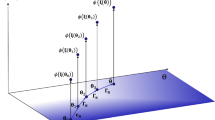Summary
Relationships were studied theoretically between phenotypic values of selection candidates (‘parents’) and economic worth of the ‘offspring’ that would belong to production populations. The candidates could include individuals, crosses or clones, and the offspring could be produced either sexually or vegetatively. Cases considered included: three systems for generating production populations [clonal propagation, pair(full-sib)crosses and half-sib crosses]; three economic-worth (profit) functions for individual offspring (linear, intermediate optimum, acceptable versus cull); and independently varying heritabilities for both parents and offspring. The heritabilities were varied in the model against a background of fixed genetic variance. Parental values were considered in terms of phenotypic standard deviations from the population mean, assuming normality. Lower heritabilities and, to a lesser extent, genetic segregation severely damped down the non-linearities of economic worth in relation to measured parental values, such that the linear weightings for traits in a selection index should usually be a good approximation, provided the profit function for individual offspring is monotonic. The economic advantages of corrective mating within a select population may be minimal if both heritabilities are low and the profit functions apply to individual offspring. The economic advantages accruing from genetic uniformity of clones (or crosses between inbreds) in conjunction with non-linear profit functions are strongly dependent on achieving high broad-sense heritabilites, particularly in the offspring (production population).
Similar content being viewed by others
References
Abramowitz M, Stegun IA (1970) Handbook of mathematical functions, 9th printing. Dover, New York
Allaire F (1980) Mate selection by selection index theory. Theor Appl Genet 57:267–272
Baker RJ (1986) Selection indices in plant breeding. CRC Press, Boca Raton
Itoh H, Yamada Y (1988) Linear selection indices for non-linear profit functions. Theor Appl Genet 75:553–560
Kempthorne O, Nordskog AW (1959) Restricted selection indices. Biometrics 15:10–19
Pesek J, Baker RJ (1969) Desired improvement in relation to selection indices. Can J Plant Sci 49:803–804
Tallis GM (1962) A selection index for optimum genotype. Biometrics 18:120–122
Wilton JW, Evans DA, Van Vleck LD (1968) Selection indices for quadratic models of total merit. Biometrics 24:937–949
Wricke G, Weber WE (1986) Quantitative genetics and selection in plant breeding. de Gruyter, Berlin
Author information
Authors and Affiliations
Additional information
Communicated by J. S. F. Barker
Rights and permissions
About this article
Cite this article
Burdon, R.D. Implications of non-linear economic weights for breeding. Theoret. Appl. Genetics 79, 65–71 (1990). https://doi.org/10.1007/BF00223788
Received:
Accepted:
Issue Date:
DOI: https://doi.org/10.1007/BF00223788



